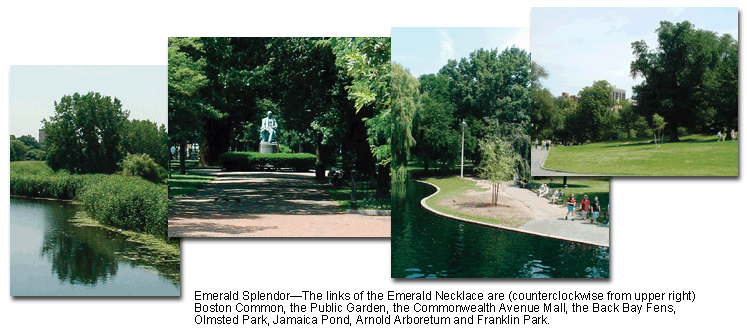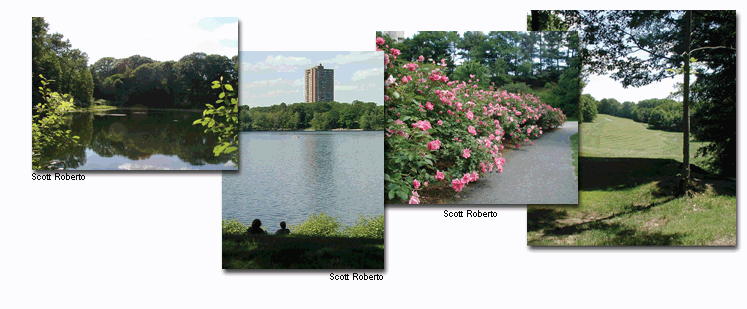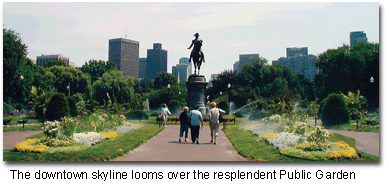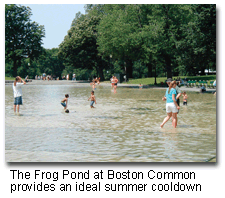The JEWEL of the Hub
Panorama explores the links that make up
Boston's glorious Emerald Necklace
by Scott Roberto
photos by Kristin Kammerer except where indicated


In today's current debates over balancing new development with open space in Boston, perhaps our civic leaders should take their cues from the past-the 19th century, to be precise. In the 1800s, much like today, there was a clamor for urban parks in increasingly industrialized cities. Frederick Law Olmsted, universally recognized as the father of American landscape architecture, believed that scenic green spaces could "bring peace and refreshment to the city dweller," thus bringing a touch of the pastoral to otherwise bustling metropolises. Already known for helping to design New York City's Central Park, Olmsted was first consulted in 1875 by local park authorities to plan a "parkway" in Boston. This led to the birth of the Emerald Necklace, a seven-mile swath of greenery arcing across the city that Olmsted devoted nearly two decades of his life to perfecting.
 Occasional
Emerald Necklace hikes are led by Boston Park Rangers. The next one takes
place August 10 from 10:30 a.m.-4:30 p.m. and departs from the Boston
Common Visitor Center on Tremont Street. Call 617-635-7383 for more
information. Also, to further explore the impact of Olmsted on Boston and
the nation, visit the Frederick Law Olmsted National Historic Site at his
"Fairsted" estate, which was home to the design firm he established in
1883 (79 Warren St., Brookline, near the Brookline Hills stop on the D
branch of the Green Line, 617-566-1689, Fri-Sun 10 a.m.-4:30 p.m., free
admission). The following survey describes the individual "links" that
constitute Boston's quintessential urban oasis, which has served as an
inspiration for countless city park systems worldwide.
Occasional
Emerald Necklace hikes are led by Boston Park Rangers. The next one takes
place August 10 from 10:30 a.m.-4:30 p.m. and departs from the Boston
Common Visitor Center on Tremont Street. Call 617-635-7383 for more
information. Also, to further explore the impact of Olmsted on Boston and
the nation, visit the Frederick Law Olmsted National Historic Site at his
"Fairsted" estate, which was home to the design firm he established in
1883 (79 Warren St., Brookline, near the Brookline Hills stop on the D
branch of the Green Line, 617-566-1689, Fri-Sun 10 a.m.-4:30 p.m., free
admission). The following survey describes the individual "links" that
constitute Boston's quintessential urban oasis, which has served as an
inspiration for countless city park systems worldwide.
Boston Common
Pre-dating Olmsted's heyday by over 200 years, Boston Common was later
incorporated as part of the Necklace and is considered its starting point.
Established in 1634, it was originally intended as a place for the grazing
of livestock, the training of troops, and as a public gathering place for
such popular Puritan pastimes as the hanging of Quakers and other
heretics. Today, it's still a favorite gathering place, although cattle
feeding and public executions were unceremoniously halted in the early
19th century. Home to tennis courts, ball fields, the Frog Pond wading
pool, a playground and many historic monuments, the Common remains a
living symbol of the Hub. The Park Street "T" stop and the Green Line's
Boylston stop are both located on the park.
 The
Public Garden
The
Public Garden
Across Charles Street from the Common lies the next "link" in the
Necklace. The Public Garden became America's first public botanical garden
in 1837 and has hosted the famous Swan Boats on its central lagoon since
1877. An idyllic spot for relaxing in the sun or shade, the Garden is lush
with myriad flora, conveniently labeled for the curious. It also contains
many notable statues, including a monumental example of George Washington
on his horse and a re-creation of the beloved ducklings and their mother
from the children's classic Make Way for Ducklings. Besides the boats, the
lagoon is home to the stately swans, Romeo and Juliet, as well as throngs
of ducks and geese. The Arlington Green Line station is right across the
street.
The Commonwealth Avenue Mall
America's most strikingly beautiful residential street, "Comm. Ave.," as
it's know to locals, is divided by a stretch of green ("The Mall") that
connects the Public Garden to the rest of the Emerald Necklace. This Back
Bay favorite is a virtual outdoor sculpture park, populated by a host of
monuments, including a somber firefighter's memorial commemorating the
nearby Hotel Vendome fire of 1972, in which nine Boston jakes perished.
The Mall is located near the Green Line's Arlington, Copley and Hynes/ICA
stops.
 The
Back Bay Fens
The
Back Bay Fens
This is where Olmsted first began to work his magic in Boston. Formerly a
swamp, the Fens was transformed by a brilliant drainage system to control
the flows of Stony Brook and Muddy River, which empty into the area. It is
a lovely garden spot, with numerous residential vegetable and flower
patches, as well as the oldest remaining World War II Victory Garden in
the country and the colorful Kelleher Rose Garden, established in 1930.
The Fenway stop on the Green Line is nearby.
The Riverway
Obscure and tranquil, this hideaway is a narrow, sunken strip of land that
follows the banks of the Muddy River, forming Boston's eastern border with
neighboring Brookline. Popular for biking, the tree-lined Riverway is also
a perfect spot for a quiet stroll in the shade. The park is adjacent to
the D Line's Longwood stop. A walk sponsored by the Olmsted National
Historic Site, The Riverway: A Tale of Mud and Magic, meets at Longwood on
August 18 at 1 p.m. for a free guided tour.
Olmsted Park
Also straddling the Muddy River, this park features two ponds: the
larger, geese-choked Leverett Pond (more peaceful on the Brookline side)
and the secluded Wards Pond, an ideal summer fishing hole. Originally
considered part of the park surrounding nearby Jamaica Pond, it was
re-named for Olmsted in 1900. Olmsted Park lies between two Green Line
stops: Brookline Village on the D train and Riverway on the E train.
Jamaica Pond
Pristine and picturesque, this sparkling, 60-acre kettle-hole lake was
Boston's first reservoir and measures up to 90 feet deep in some spots.
Olmsted included the surrounding area as a link in the Necklace in 1892,
making only minor modifications. A boat house, still in use, was added a
few years later. Fishing, jogging and biking are popular here (swimming is
not allowed), as well as boating. Non-residents can rent rowboats for $12
an hour, while sailboats are available for $20 an hour. Call 617-522-6258
for more information. Jamaica Pond is not only a favorite for people, but
wild animals as well-everything from deer to coyotes to wild turkeys have
been known to visit its shores. Details on these and other resident
critters can be found at the Boston Park Ranger Nature Center next to the
boat house. The E train's Heath Street Station on the Green Line is a few
blocks north.
Arnold Arboretum
Designed by Olmsted in collaboration with the Arboretum's original
director Charles Sprague Sargent, this 265-acre botanical
garden-established in 1872 and operated by Harvard University-was, in the
words of its bequest, meant to contain "all the trees [and] shrubs.either
indigenous or exotic, which can be raised in the open air." Home to
species from North America and Asia, the well-marked trails and walkways
are perfect for nature walks, the botanically curious, or anyone who
appreciates the beauty of the natural world. A notable attraction is the
Larz Anderson Bonsai Collection, donated in 1937. The Arboretum, still a
vital botanical research center, offers free guided tours on alternate
Wednesdays, the next one falling on August 14 at 12:15 p.m., departing
from the Hunnewell Building. A one-hour seasonal flower tour is held on
August 17 at 10:30 a.m. The nearest "T" stop is Forest Hills on the Orange
Line.
Franklin Park
The largest of the Emerald Necklace's jewels, this 500-acre playground is
home to a municipal golf course (see listing in Outdoor Recreation, page
25), a zoo (see listing in Sightseeing, page 57), ball fields, tennis
courts, a stadium, hiking and walking trails and the seven-acre Scarboro
Pond. The park is a bucolic summer retreat and is also home to many free
community celebrations, including the upcoming Dominican Festival on
August 9-11. The best way to the park is via Forest Hills Station, then
switching to the Number 16 bus to the zoo.

back to homepage